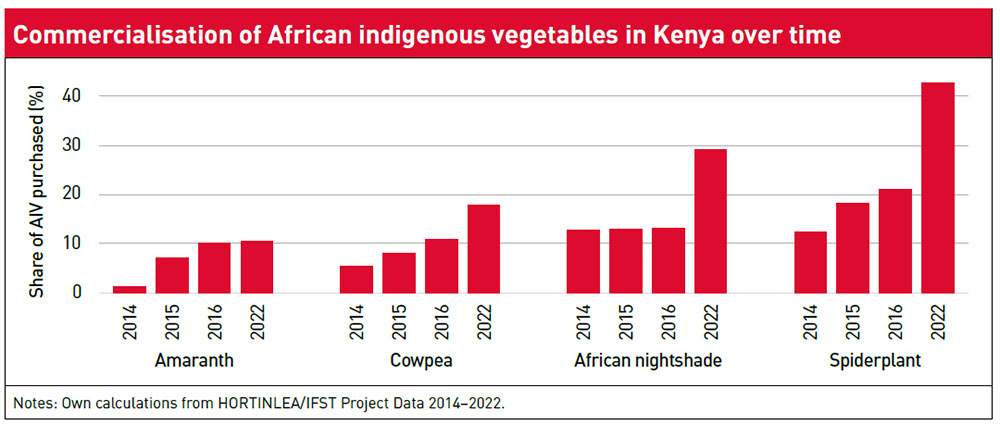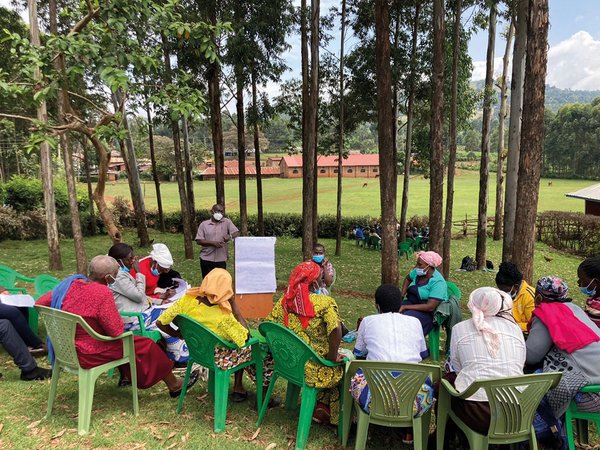 Download this article in magazine layout
Download this article in magazine layout
- Share this article
- Subscribe to our newsletter
The socio-economic effects of the commercialisation of African indigenous vegetables
For a long time, African indigenous vegetables (AIV) were part of the local diet in Kenya, but exotic vegetables dominated the commercial vegetable market. The more affluent urban population preferred exotic vegetables such as kale or cabbage (Brassica oleracea var. acephala). Neither were AIV yet widely recognised for their positive effects on nutrition and health or their resilience to climate change events. This has changed in recent decades, and AIV are becoming more prominent on markets (also see Figure). While the commercialisation of subsistence agriculture in sub-Saharan Africa is often seen as essential to increase smallholder incomes, its impact on nutritional intake is often unclear. At the same time, resource-sharing within farming communities and gender equality may actually decrease.

Within the framework of the inter-/transdisciplinary project “Inclusive Food System Transition – Social Cohesion, Food and Health” (IFST) of three universities in Berlin, Germany, our subproject on nutrition-sensitive value chains of AIV in Kenya analyses the trade-offs between smallholder farmers’ income, nutritional intake, solidarity within their networks and gender relations in the two counties Kisii and Kakamega in cooperation with Egerton University in Kenya. In both counties, AIV have a large economic potential. In Kisii, land sizes are very small and AIV that can be produced in smallholdings can hence contribute significantly to household income. In contrast, sizable sugarcane production was historically located in the county of Kakamega. Yet production collapsed in recent years, leaving a large share of farmers in poverty. Considering increasing poverty and also decreasing land sizes, AIV are now also an important alternative to sugarcane in the county.
Our project builds on quantitative panel surveys of smallholder farmers between 2016 and 2022 and qualitative data from 20 focus group discussions (FGDs) with male and female farmers in 2022. The panel surveys looked at the long-term effects of commercialising AIV on local and regional markets as well as its impact on income, nutritional intake and social cohesion. The latter aspect was also addressed in the FGDs, which otherwise investigated the effects of commercialising AIV on gender relations.
Panel data models show that, in the period reviewed, household income of smallholder farmers in the two counties has significantly increased, with AIV commercialisation – moving from no commercialisation to complete commercialisation – having raised households’ expenditures on non-food items by almost 24 per cent on average between 2016 and 2022. Our results also suggest that AIV commercialisation did not negatively affect nutrition outcomes such as dietary diversity of smallholder farmers since it also led to an expansion of AIV acreage which kept the health-promoting effects of vegetable consumption stable. But neither did it improve nutrition outcomes as the additional income was not spent on food items, but on areas such as school fees or technologies for farming and processing, e.g. solar dryers.
Community social interaction and gender relations
Apart from income and nutrition intake, indigenous vegetables are an integral part of community social interaction, too, as they have also traditionally been used as gifts between households. Their commercialisation may thus reduce resource sharing within social networks and alter perceptions of solidarity within rural communities. As our surveys have demonstrated, at about one or two per cent, the share of AIV and of other crops that was given away to other households for free was already marginal in 2016. However, our data indicate that households which market their AIV production more frequently have reduced not only the share of AIV production for their own use, but also cut down the share of AIV production given away to other households to almost zero with a reduction by two percentage points.
Concerning the affiliated effect on community solidarity and social cohesion, our results are inconclusive. We found no consistent and significant evidence that solidarity within farming communities had changed over time with AIV commercialisation. Neither did the focus group discussions reveal any unidirectional effect on solidarity, but instead showed that multiple and sometimes opposing mechanisms were at work. For example, the FGDs made it clear that perceived solidarity has decreased due to less frequent gifts of AIV – it was reported that in the past, far more non-monetary exchanges had occurred, i.e. that more vegetables were given away, whereas today, everyone was eager to have a win-win situation.
However, some farmers emphasised that they had found this traditional form of solidarity to be partially forced through social norms. In the wake of commercialisation, other forms of social interaction have however also emerged, such as cooperatives (e.g. women farmers associations) and more intensive knowledge sharing.
Indicators for measuring social cohesion and gender relations
In order to survey social cohesion in the context of the IFST case study “Nutrition-sensitive value chains of African indigenous vegetables in Kenya”, quantitative data for both 2016 and 2022 was gathered. Here, the personal satisfaction of respondents with their community integration/social integration, supportive interaction with their neighbours as well as satisfaction with social equality in their village/community was elicited. In addition, trust in traditional and governmental institutions has been measured across years. For this purpose, scorecards ranging from 1 to 10 were used. In terms of gender relations, the respondents were asked to indicate which member of the household was responsible for decision-making in various production steps, such as AIV cultivation or marketing. For the qualitative data gathered in the focus group discussions, the following indicators for social cohesion were used: perceived fairness, solidarity within farming communities, informal sharing arrangements and trust. For gender relations, the following aspects were covered: participation and agricultural labour, decision-making power and access to land and financial resources in Kenya.
For decades, African indigenous vegetables were mostly grown by women for subsistence, and women’s farming activities are known to have a great influence on nutritional intake, livelihood, and resilience outcomes in sub-Saharan Africa. Hence, our project also examined the effect of commercialisation on the gendered division of labour, decision-making power, access to resources, and cooperation strategies among women and men.
The focus group discussions highlighted that once men see that AIV are profitable, they become involved in their cultivation. This is also corroborated by our panel data. For instance, we see an increase by 15 and 20 percentage points respectively in selling spider plant (Cleome gynandra) and cowpeas (Vigna unguiculata) if men are responsible for production. The data show, however, that while AIV commercialisation is associated with men becoming more involved in AIV production and decision-making over time, this does not necessarily diminish women's decision-making power. This is because women retain control over selling vegetables. As perceived by the women interviewed in the qualitative survey, this can be explained by the fact that men are not yet experienced in selling AIVs on markets because they lack knowledge on product quality and safety. In fact, maintaining control over the additional income was perceived as enhancing women’s bargaining power.
In general, however, when it comes to taking over a domain by men, women develop strategies for withdrawal rather than simply defending their domain, indicating complex intra-household dynamics that cannot be captured by a binary view of household cooperation versus conflict. But the study notes that women in the research region still face an increased labour burden due to AIV commercialisation and continue to perform most of the care work.
Summing up …
While economic empowerment through commercialisation expands women's opportunities and revenue generation, it does not address labour or land rights redistribution, which are crucial to achieving gender equality. Women's labour burden increases, and market-based interactions may replace traditional social practices, potentially also impacting social cohesion. The income gains demonstrated for producers are a strong incentive for continued growth of the AIV sector, and the insignificant effect on nutritional intake and heterogeneous concerns about the loss of community solidarity and social cohesion are unlikely to halt this trend.
In terms of policy recommendations, it is important to promote and support local and regional AIV commercialisation, recognising their potential to improve smallholder farmers' income, in particular that of women farmers. This includes developing policies for market access, training and providing resources through extension services. The research also highlights the need to invest in research on AIV to generate comprehensive data on their nutritional content, optimal cultivation techniques and post-harvest management as well as research on fortified AIV-enriched products and lesser-studied AIV. Finally, it is important to provide capacity building programmes, technical assistance and financial support to empower young people and women to foster the development of inclusive and nutrition-sensitive value chains in the horticulture sector.
Christoph Kubitza is a Postdoc at Thaer-Institute of Agricultural and Horticultural Sciences of Humboldt-Universität zu Berlin, Germany, with a research focus on the economics of smallholder farming systems in the Global South.
Sarah Hackfort is a research group leader at Thaer-Institute, with a focus on political economy of food and agriculture and feminist economics.
Susanne Huyskens-Keil is a professor at Thaer-Institute. Her research focus is on the quality dynamics and postharvest management of perishable crops.
Arnold M. Opiyo is a professor at Egerton University, Kenya, Department of Crops, Horticulture and Soil Sciences, with a research focus on post-harvest management.
Contact: susanne.huyskens@hu-berlin.de
The project was conducted in cooperation with IFST project partners Prof Caroline Stokes, Humboldt-Universität zu Berlin and Prof Cornelia Rauh and MSc Ann-Marie Kalla-Bertholdt, Technische Universität Berlin. We gratefully acknowledge the financial support of the German Excellence Initiative/Berlin University Alliance.
References
Abukutsa-Onyango, M. (2007). The diversity of cultivated African leafy vegetables in three communities in Western Kenya. African Journal of Food, Agriculture, Nutrition and Development 7 (3), 85–91.
Bokelmann, W.; Huyskens-Keil, S.; Ferenczi, Z.; & Stöber, S. (2022). The Role of Indigenous Vegetables to Improve Food and Nutrition Security: Experiences from the Project HORTINLEA in Kenya (2014–2018). With assistance of Humboldt-Universität zu Berlin.
Carletto, C.; Corral, P.; & Guelfi, A. (2017). Agricultural commercialization and nutrition revisited: Empirical evidence from three African countries. Food policy 67, 106–118.
Mwadzingeni, L.; Afari-Sefa, V.; Shimelis, H.; N’Danikou, S.; Figlan, S.; Depenbusch, L. et al. (2021). Unpacking the value of traditional African vegetables for food and nutrition security. Food Security 13, 1215–1226.
van Asselt, J.; & Useche, P. (2022). Agricultural commercialization and nutrition; evidence from smallholder coffee farmers. World Development 159, p. 106021.
von Braun, J.; Afsana, K.; Fresco, L.O.; Ali-Hassan, M.H. (2023). Science and Innovations for Food Systems Transformation. Springer Verlag. doi.org/10.1007/978-3-031-15703-5.





Add a comment
Be the First to Comment